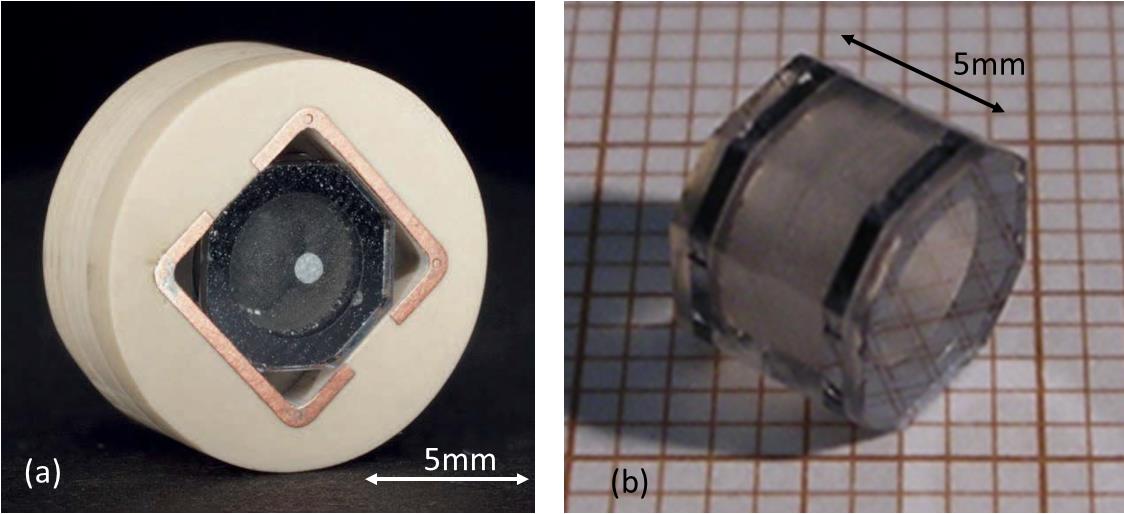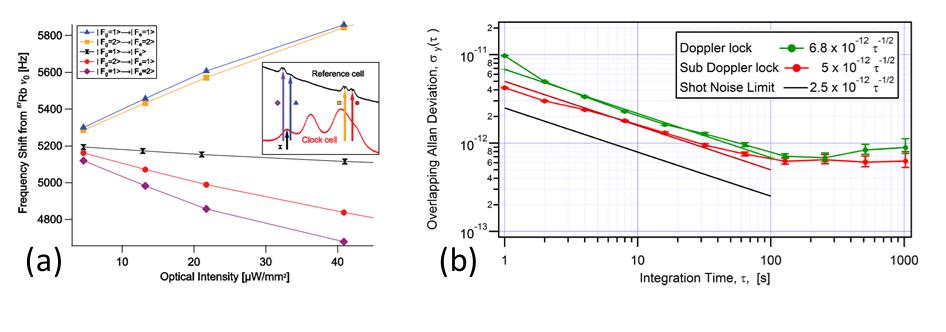MACQS: Miniature atomic clocks and quantum sensors
Key members
- Prof. Gaetano Mileti (gaetano.mileti@unine.ch)
- Dr. Christoph Affolderbach (christoph.affolderbach@unine.ch)
Within the miniature atomic clocks and quantum sensors (MACQS) project (http://macqs.epfl.ch/) the objective was to develop and study the key building blocks required for the realization of miniature double-resonance (DR) atomic clocks and quantum sensors. Such miniature atomic clocks may have potential applications in satellite navigation and positioning, secure telecommunications, mobile timing applications, and others. Essentially all previous developments on miniature atomic clocks were based on the coherent population trapping (CPT) scheme (see e.g. S. Knappe, “MEMS atomic clocks,” in Comprehensive Microsystems, vol. 3, Elsevier, 2008). This project follows an alternative and complementary approach, by focussing on a miniature atomic clock based on the optical-microwave DR scheme. This approach is motivated by the fact that the DR scheme has been shown to allow 5-times better clock stabilities than the CPT scheme, for a vapour cell of the same size. The project consortium is formed by 5 research teams from University of Neuchatel (UniNe) and Ecole Fédérale de Lausanne (EPFL), focussing on different aspects of the project:
UniNe-LTF (prof. G.Mileti): atomic clock physics and spectroscopy.
- EPFL-SAMLAB (prof. N. de Rooij): micro-fabrication and miniature vapour cells.
- EPFL-LMTS (prof. H. Shea): micro-systems and miniature Rb discharge lamp.
- EPFL-LEMA (prof. A. Skrivervik): miniature microwave resonators.
- EPFL-LPM2 (Dr. T. Maeder): micro-systems, materials, and packaging.
Main achievements of the project include the development of new types of Rb vapour cells, such as a multi-layer Si-glass vapour cell using 4 steps of anodic bonding (Figure 2b, [4]). This fabrication method allows the wafer-level fabrication of alkali vapour cells with ≥ 1mm inner length and diameter with excellent optical quality of the cell windows, which is difficult to achieve with other existing technologies. In view of the exploitation of anti-relaxation wall coatings in micro-fabricated cells, a new low-temperature indium thermocompression cell sealing technique was developed (Figure 1a, [3]). Using this technique, micro-fabricated Rb vapour cell with an OTS wall coating was realized, and the presence of an operational anti-relaxation wall-coating was confirmed by spectroscopy measurements (Figure 1b+c, [2]).
A novel miniaturized microwave resonator, the µ-LGR, was developed for efficient and controlled coupling of the microwave radiation to the alkali atoms held in the vapour cells (Figure 3a, [4]). This resonator is based on a classical loop-gap resonator design, but has a total size well below the microwave’s wavelength. It is manufactured by electrode patterning onto dielectric substrates followed by a stacking process, which allows parallel and efficient fabrication of this resonator type.
Based on the developed components and different laser sources, spectroscopic studies on the clock operation were conducted, to validate the developed components and for evaluation of systematic effects and frequency shifts affecting the clock operation (Figure 3, [3,4]). Clock operation using the µ-LGR shows excellent clock stability down to the level of 10-12 at 1000 seconds integration time (fractional frequency stability or Allan deviation), which shows the high potential of this type of miniaturized atomic clock for demanding future applications such as e.g. in smart-grids.
Inspired by the principle of plasma screen displays, a miniature Rb discharge lamp was developed, operating in the dielectric barrier discharge scheme (Figure 4a, [7]). With this lamp, successful optical pumping in a micro-fabricated Rb vapour cell could be demonstrated (Figure 4b, [6]).

Figure 1: a) micro-fabricated Rb vapour cell using low-temperature indium bonding [3]. b) design and photograph of a micro-fabricated Rb vapour cell equipped with an anti-relaxation coating [2]. Example of a DR signal obtained from the wall-coated micro-fabricated cell [2].

Figure 2: a) The micro-loop-gap resonator (-LGR) [6] developed in this project for operation with the thick-core microfabricated vapour cell [5]. Overall diameter of the cylindrical substrate is 11 mm. b) the thick-core micro-fabricated cell [5].

Figure 3: Clock studies of DR interrogation in micro-fabricated Rb cells. a) Light-shift measurements in a buffer-gas filled microcell [7]. b) measured clock stabilities for a miniature DR clock using the -LGR [8].

Figure 4: a) developed miniature Rb discharge lamp [7]. b) first demonstration optical pumping by Zeeman DR signals in a microfabricated Rb cell [6]. c) The envisioned miniature DR Rb atomic clock, consisting of a micro-fabricated Rb plasma light source, an optional micro-fabricated filter, a micro-fabricated Rb resonance cell enclosed by a miniaturized microwave cavity, and a photodetector.
This research was supported by the Swiss National Science Foundation, sinergia grant 122693, “Miniature atomic clocks and quantum sensors”.
Relevant publications
- M. Pellaton, C. Affolderbach, Y. Pétremand, N. de Rooij and G. Mileti, Study of laser-pumped double-resonance clock signals using a microfabricated cell, Physica Scripta, T149 (2012) 014013, DOI: 10.1088/0031-8949/2012/T149/014013, (2012). PDF
- R. Straessle, M. Pellaton, C. Affolderbach, Y. Pétremand, D. Briand, G. Mileti, N. F. de Rooij, Microfabricated alkali vapor cell with anti-relaxation wall coating, Applied Physics Letters 105 (4), 043502 (2014). PDF
- R. Straessle, M. Pellaton, C. Affolderbach, Y. Petremand, D. Briand, G. Mileti and N. F. de Rooij, Low-temperature indium-bonded alkali vapor cell for chip-scale atomic clocks, Applied Physics 113, issue 6, 064501/1-8, (2013). PDF
- Y. Pétremand, C. Affolderbach, R. Straessle, M. Pellaton, D. Briand, G. Mileti and Nico F. de Rooij, Microfabricated rubidium vapour cell with a thick glass core for small-scale atomic clock applications, Journal of Micromechanics and Microengineering, 22, 025013, (2012). PDF
- M. Violetti, M. Pellaton, F. Merli, J.–F. Zürcher, C. Affolderbach, G. Mileti, A. K. Skrivervik, The Micro Loop-Gap Resonator: A Novel Miniaturized Microwave Cavity for Double-Resonance Rubidium Atomic Clocks, IEEE Journal of Sensors 14 (9), 3193 – 3200 (2014). PDF
- V. Venkatraman, S. Kang, C. Affolderbach, H. Shea and G. Mileti, “Optical pumping in a microfabricated Rb vapor cell using a microfabricated Rb discharge light source”, Applied Physics Letters, 104, issue 5, 054104 -1/4, (2014). PDF
- V. Venkatraman, Y. Pétremand, C. Affolderbach, G. Mileti, N. F.de Rooij, H. Shea, “Microfabricated chip-scale rubidium plasma light source for miniature atomic clocks”, IEEE Trans. Ultrason., Ferroelectr., Freq. Control. Vol. 59, No. 3, pp. 1-9, (2012). PDF
- M. Pellaton, C. Affolderbach, G. Mileti, M. Violetti, J.-F. Zürcher, A. K. Skrivervik, “Double resonance spectroscopic studies using a new generation of microfabricated microwave cavity”, proceedings of the 2013 Joint UFFC, EFTF and PFM Symposium, Prague, Czech Republic, July 21-25, 2013, pp. 582-585. PDF
- F. Gruet, F. Vecchio, C. Affolderbach, Y. Pétremand, N. F.de Rooij, T. Maeder, G. Mileti, A miniature frequency-stabilized VCSEL system emitting at 795 nm based on LTCC modules, Optics and Lasers in Engineering, 51, issue 8, 1023–1027, (2013). PDF

